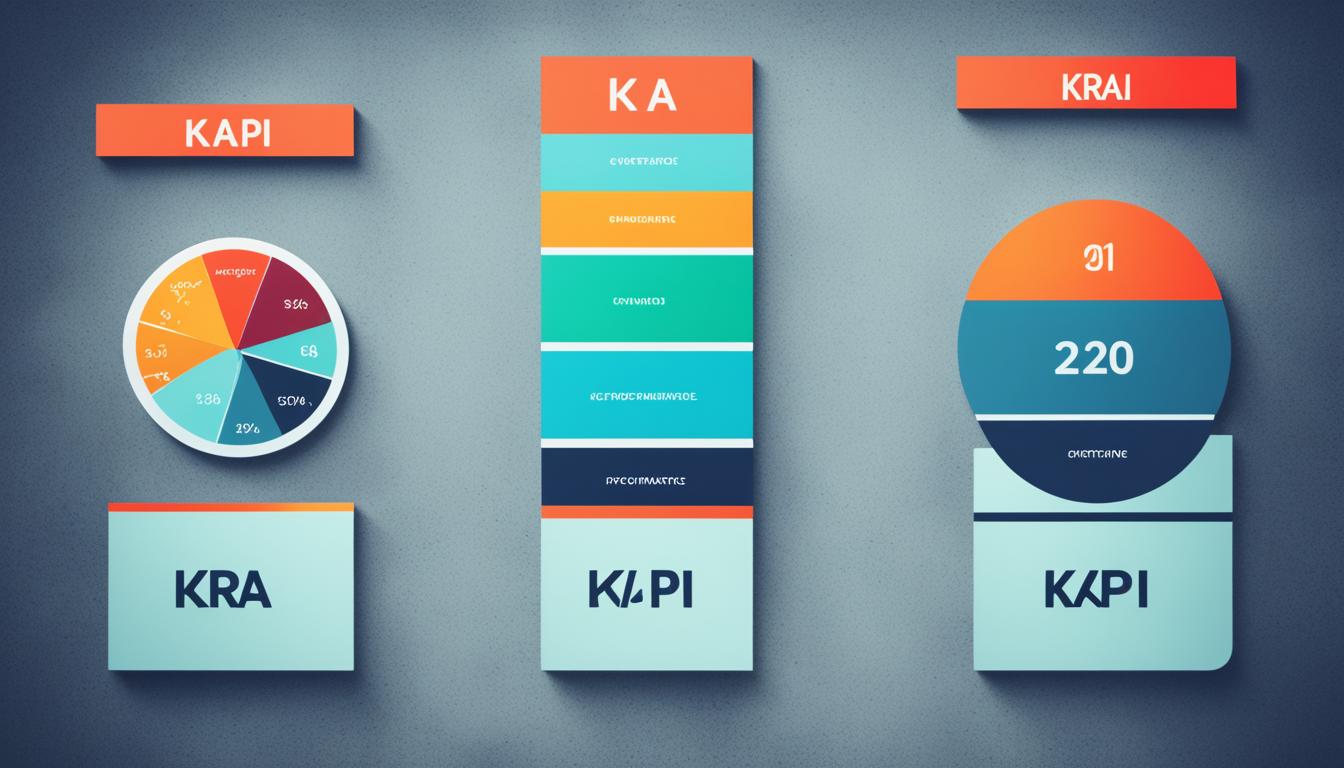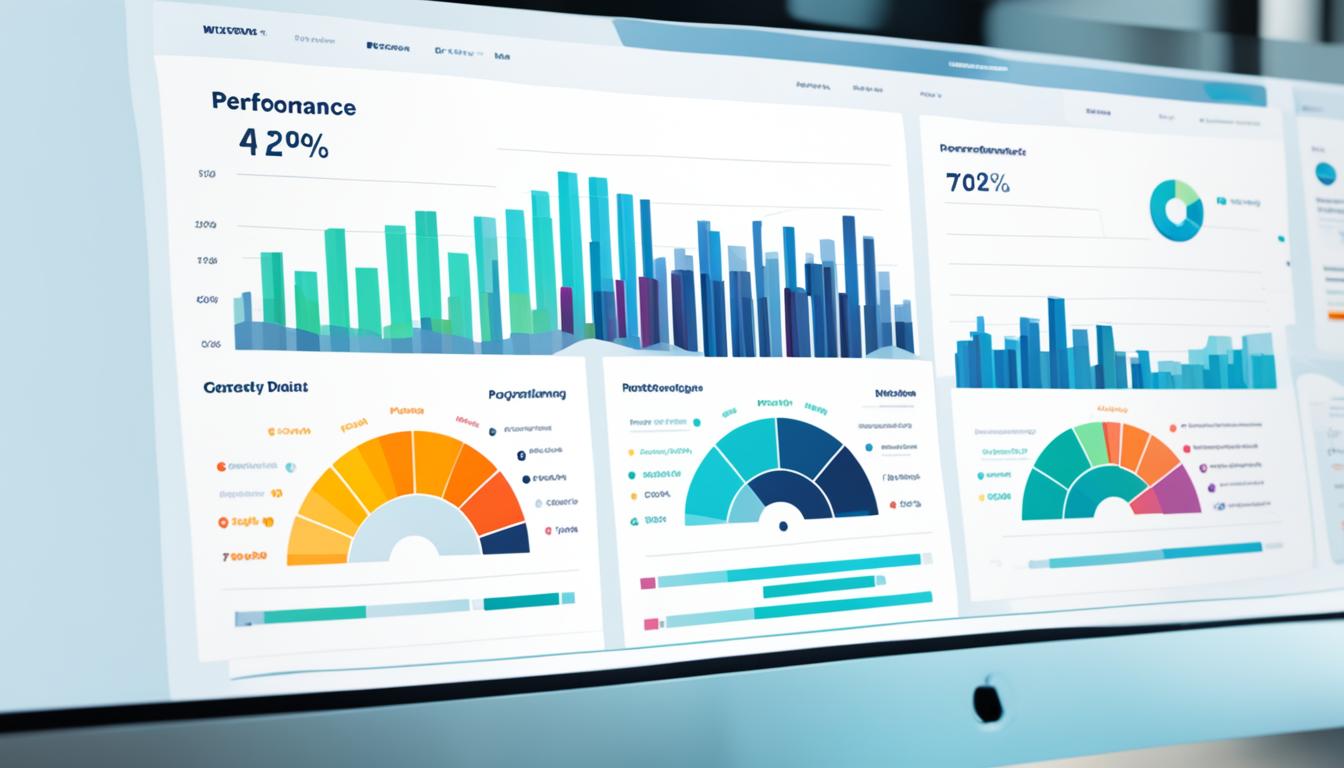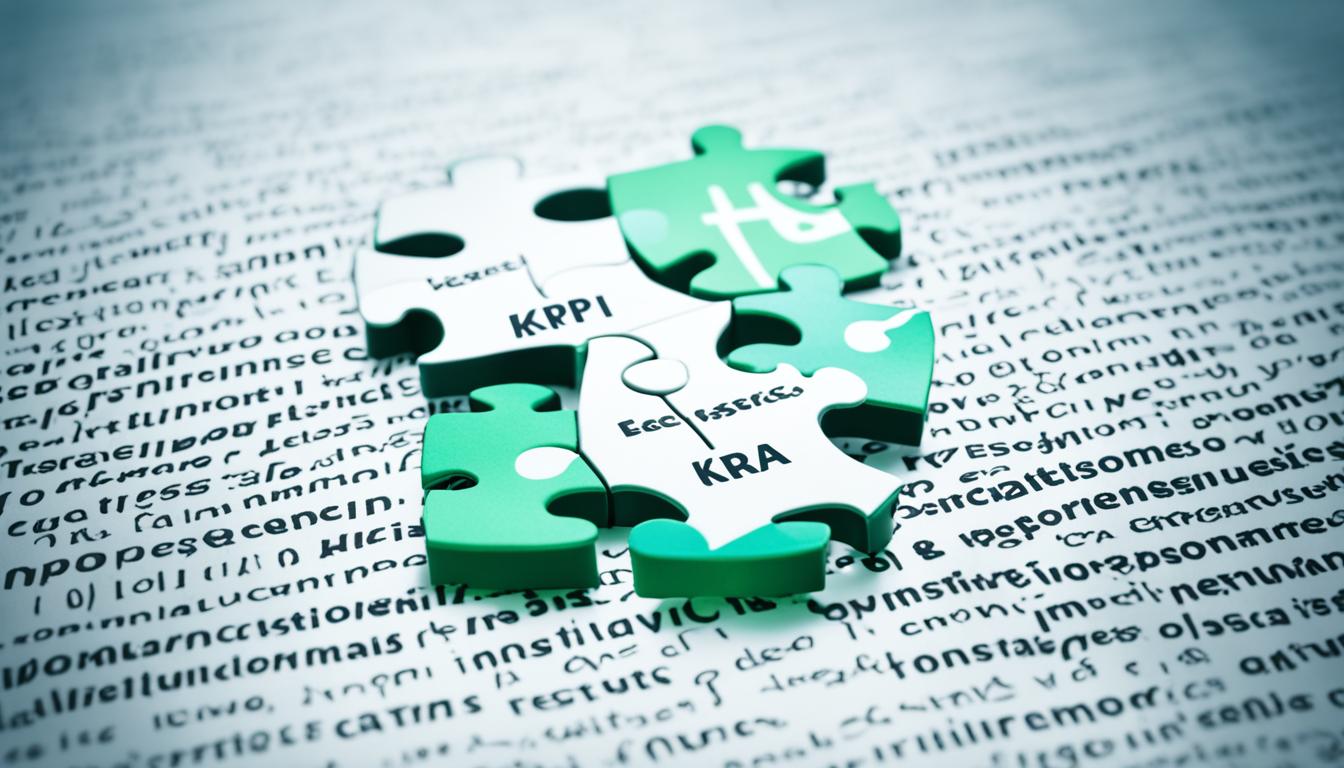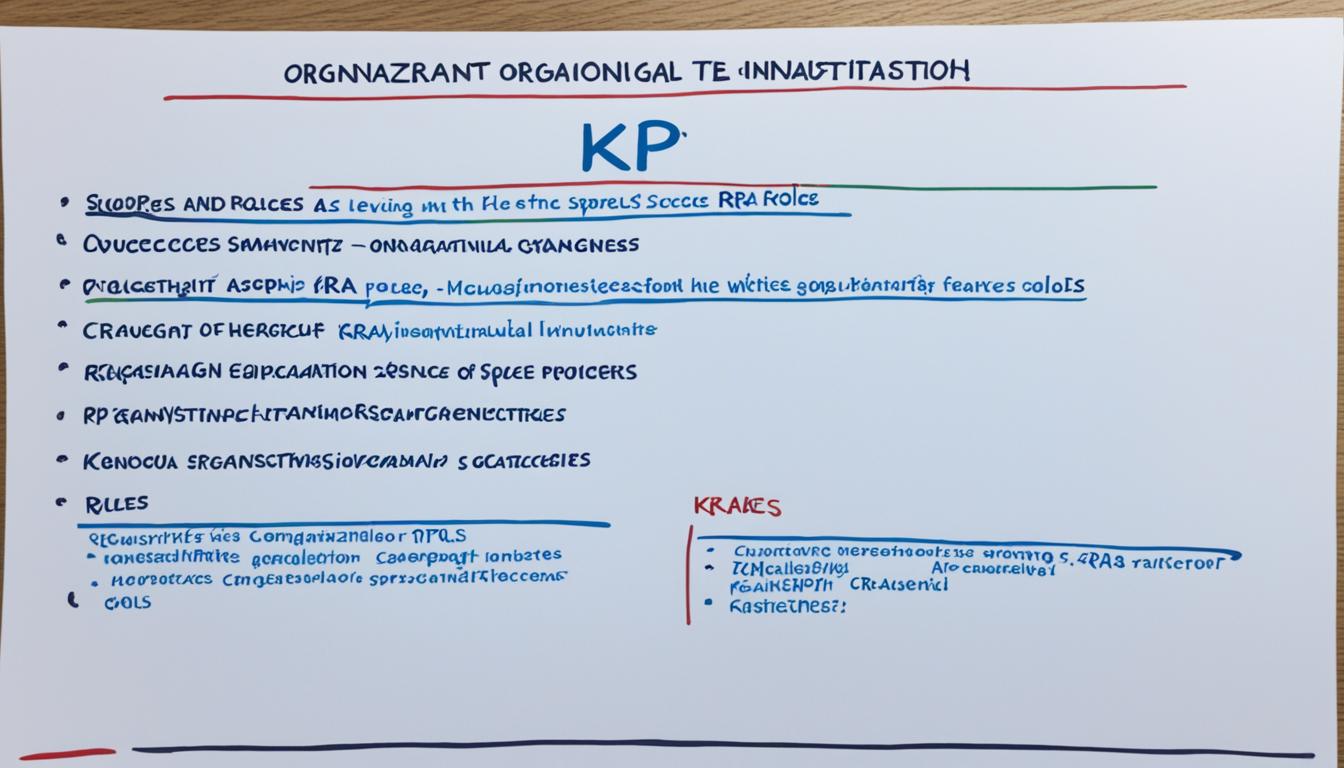Two essential metrics for measuring performance are Key Result Areas (KRAs) and Key Performance Indicators (KPIs). They are crucial for understanding how well an organization is performing. But what’s the difference between them? Are they the same, or do they serve distinct purposes? This article explores the unique features of KRAs and KPIs and how they work together to boost success.
Key Takeaways:
- KRAs and KPIs are both vital performance metrics used in organizations.
- KRAs are broad areas of responsibility or goals that individuals, teams, or departments are expected to achieve.
- KPIs are specific, measurable indicators used to track progress towards achieving specific goals or objectives.
- KRAs are qualitative in nature, focusing on overall goals, while KPIs are quantitative and measure specific metrics.
- Aligning KRAs and KPIs is crucial for driving performance and achieving organizational objectives.
Deciphering the Essentials: What are KRAs?
Key Result Areas (KRAs) guide how we evaluate performance in companies. They cover big areas of responsibility or goals for people, teams, or parts of a company. KRAs bring clarity and focus, helping staff prioritize and work towards common goals.
Defining Key Result Areas
KRAs focus on the bigger picture, not just numbers like Key Performance Indicators (KPIs). They set out goals that help a company move in the right direction. KRAs give a broad view of what each part of a company is responsible for.
For instance, a sales team’s KRA might be “Growing sales and market presence through key partnerships and entering new markets.” This shows the team’s main goals clearly, without detailed numbers or targets.
Aligning KRAs with Organizational Objectives
It’s key that KRAs fit with what the whole company is trying to achieve. This makes sure individual and team efforts push the company forward. Connecting KRAs to company goals shows how everyone’s work matters. This understanding helps prioritize work and resources.
If a company aims to boost customer happiness, a KRA for customer service might be making customer interactions smoother by solving issues fast and giving personal help. This KRA ties the team’s efforts directly to the goal of making customers happier.
Impact of KRAs on Strategic Planning
KRAs are central in mapping out a company’s strategy. They highlight key areas where success is crucial. Pinpointing these areas lets a company focus its efforts and plan well to meet its goals.
Merging KPIs with KRAs improves strategic planning. KPIs keep track of how well KRAs’ goals are being met. They give crucial insights for assessing performance and deciding where resources should go.
Demystifying KPIs: More Than Just Numbers
Key Performance Indicators (KPIs) are like maps for measuring how you’re doing on your goals. They show more than just numbers. KPIs share insights into what’s working well and what needs tweaking in a company.
Understanding Key Performance Indicators
KPIs are like signs that help you keep track of how well you’re doing. They show if you’re hitting your goals. These signs can be all about the numbers, like how much money you make. Or they can be about how happy your customers are.
Quantitative Nature of KPIs
KPIs love numbers. They help you measure things in a clear, fair way. This helps you see what’s going well and what might need a boost. By looking at these numbers, companies can spot trends and work on making things even better.
Using KPIs to Measure Success
KPIs are key to figuring out if your plans are working. They give a way to check on how well you’re doing. Picking the right KPIs means you can see clearly how successful you are. This helps in deciding where to put your effort and money.
By using KPIs, companies get smart about their performance. They can see where they can do better. And then, they make changes based on what the numbers show. It’s important to keep updating your KPIs. This ensures they still reflect what you really care about and help track your wins.
Core Differences: KRA vs KPI
When looking at Key Result Areas (KRAs) and Key Performance Indicators (KPIs), it’s key to see their main differences. KRAs are about quality, covering big goals and responsibilities. KPIs use numbers to check on how specific tasks are done.
Qualitative vs Quantitative Aspects
KRAs give us the what and why, explaining goals and plans to reach them. They look at the big effects of what teams or people do. On the flip side, KPIs use hard numbers on areas like sales or how satisfied customers are. This helps to see real results and improvements.
Scope and Framework Variations
KRAs are broader, linking personal or team goals with what the whole organization aims to do. They guide important decisions and plans. KPIs zoom in on specific goals and measure clear results. They’re about actually tracking progress.
It’s essential for companies to know what makes KRAs and KPIs different. This way, they can measure and lift performance the right way. Using both kinds of measures and knowing their scopes helps to have a strong performance plan. This can lead to more success, keep everyone’s goals in line with big plans, and boost the whole team’s work.
Integration in Business: How KRAs and KPIs Complement Each Other
To improve performance in organizations, it’s vital to blend Key Result Areas (KRAs) with Key Performance Indicators (KPIs). KRAs act as guides for setting goals. On the other hand, KPIs measure how far we’ve come in reaching those goals. This mix ensures goals at all levels match up with the performance of individuals, teams, and departments.
KRAs set out the main tasks and goals of individuals or teams in a company. They give a clear focus and framework for success. By tying KRAs to what the company aims to achieve, everyone can help in planning.
This makes sure their work supports the bigger picture of what the company wants to do.
KPIs show us specific, measurable ways to track our goal progress. They tell us not just what and why something is happening. They also answer how well we’re doing. Using the right KPIs lets companies see if their plans are working or not.
This way, they can spot what works and what doesn’t easily.
By linking KRAs and KPIs, companies improve their total performance strategy. Setting clear KRAs that match up with company goals and choosing the right KPIs to follow progress helps. It lets companies keep an eye on how well they’re doing. They can then act based on real information to get better results.
The true power of integrating KRAs and KPIs lies in their collective ability to provide a comprehensive view of performance, combining qualitative and quantitative aspects.
Using both KRAs and KPIs in the correct way motivates employees to meet their targets. KRAs guide the way, and KPIs show how to tell if we’re making progress. Together, they’re a strong tool for managing performance and achieving success.
| KRAs | KPIs |
|---|---|
| Defines broad areas of responsibility and goals | Specific, measurable indicators |
| Aligns individual and team efforts with organizational objectives | Measures progress towards achieving goals |
| Provides the framework for setting goals | Quantifies performance and provides insights |
| Sets the context for success | Allows organizations to make data-driven decisions |
Purpose-Driven Metrics: Setting and Achieving Goals with KRAs and KPIs
Setting clear and measurable goals is key for any organization’s success. Key Result Areas (KRAs) and Key Performance Indicators (KPIs) help a lot. They make sure everyone in the company knows their goals. And they help track how well those goals are being met.
Framework for Employee Goals with KRAs
KRAs are like a road map for employee goals. They show what needs to be done and by who in the organization. This way, everyone knows how their work fits the big picture.
In a sales team, for instance, a KRA might be “Boost monthly sales by 10%.” This sets a clear target for the team, giving them a goal to aim for.
KRAs help everyone move in the same direction. This can improve how much work gets done and who is responsible for what. KRAs are also used to see who did a great job, and then those people can be rewarded.
Performance Measurement Using KPIs
After setting goals with KRAs, it’s crucial to measure how things are going. This is the job of KPIs. They are specific measures that tell if goals are being met.
In our sales example, a KPI could be “The average revenue made by each salesperson each month.” This KPI shows each salesperson’s impact on the goal of increasing sales.
KPIs let companies check how well they’re doing. By looking at KPIs regularly, they can find areas to do better. And they can make decisions that help them reach their goals faster.
By using KRAs and KPIs together, companies get everyone working in the same direction. Employees know what they need to do. And their progress is checked using clear, fair measurements.
This approach builds a culture where everyone is working towards the same goals. It helps employees feel motivated to do their best. And it helps companies achieve their bigger plans.
Financial Acumen: KPIs as a Barometer for Business Health
Key Performance Indicators (KPIs) are vital for checking a company’s health. They dive into the money side of things. This lets people involved know how well the business is doing.
By keeping track of KPIs, companies see their financial performance clearly. This helps them make smart choices to grow and succeed.
Gauging Profitability and Efficiency
Great KPIs offer a peek at how well a company makes money and works. Looking at things like how much money is made and how much is kept as profit shows the big picture. These KPIs help a company check its success against standards and fix what’s needed to make more money.
On the flip side, efficiency KPIs show how well a company uses its resources to make money. They look at things like how much each worker brings in, the cost of making a product compared to its selling price, and how quickly a storehouse clears out its goods. With this info, a business can spot and fix things not running smoothly.
Operational Expenditure Insights
KPIs also shed light on what a company spends money on. They look into costs to help manage spending, see where money goes, and how well it’s being used. These metrics cover how much is spent on running the business, cost for each item sold, and more.
Watching these KPIs helps cut down on overspending and use money better. By being careful with spending and organizing operations well, companies get stronger financially.
Stay on Top of Your Business’s Financial Health with KPIs
Using KPIs to check a business’s health is key for smart decision-making. It’s important to look at how money is made, spent, and used. This helps find ways to do better and achieve financial goals in the Philippines and elsewhere.
Structural Implementation: KPI and KRA in Organizational Hierarchy
Setting up Key Performance Indicators (KPIs) and Key Result Areas (KRAs) in a company is key. It helps drive performance and meet big goals. These tools help define and watch over roles, ensuring they match the company’s aims.
Roles and Responsibilities Outlined by KRAs
KRAs clearly lay out what each person, team, or department should achieve. They make sure employees know what to focus on and the performance expected. This helps everyone understand their part in the bigger picture.
Think of a store manager’s KRA in a retail setting. It could list tasks like boosting sales, making customers happier, and managing stock better. With these duties set, the manager knows what to prioritize and how to meet these goals.
These KRAs can be handed down through all levels of the company. This connects everyone’s work to the company’s main strategies. It makes sure every employee knows how their work adds to the company’s success.
Performance Monitoring Through KPIs
KPIs keep an eye on how well tasks and goals are being met. They use specific numbers to show if someone or a team is doing well. For example, a store manager’s KPIs might include sales reports, how happy customers are, and how fast stock moves.
Checking KPIs helps teams see what they’re doing right and where they need to do better. This way, they can keep improving and meeting the company’s goals. It’s all about using proof to see who’s on track and who needs help.
With KPIs and KRAs, a company can link individual and team work to the big goals. This brings clarity, honesty, and lots of room to grow. Every person learns how their work affects the company and how they can do better.
In Practice: KPI- and KRA-Based Evaluations for SMEs
For small and medium-sized enterprises (SMEs), using KPIs and KRAs is key. These methods help measure performance. They make sure every worker helps the business succeed.
Measurable Outcomes as Business Benchmarks
Setting measurable outcomes is a big advantage. This lets SMEs know if they’re succeeding. It shows what needs to get better.
Imagine a small retail store aiming to boost sales by 10%. This goal lets them check how well their sales plans work. They can make changes to do better.
Aligning Employee Performance with Company Objectives
Linking what employees do with company goals is crucial. KPIs and KRAs make sure everyone helps meet these goals.
So, if you’re in customer service, your goal might be to keep customers happy. Or, to solve their issues faster.
Using KPIs, companies can check how well employees do. This helps find who needs more training or who’s doing great. It also encourages everyone to work towards the company’s goals.
| Benefits of KPI- and KRA-Based Evaluations for SMEs | In Practice: Steps for Successful Implementation |
|---|---|
|
|
Conclusion
Understanding and using performance metrics like KRAs and KPIs are key for improving and measuring success in organizations. Knowing the difference between these terms is essential. It helps connect personal and team goals with what the company wants to achieve.
KRAs are like a big picture, showing what goals and duties everyone should focus on. On the other hand, KPIs are the tools that measure how well these goals are being met. Picking the right KPIs lets companies see how they’re doing. This info helps make smart choices to grow and succeed.
KRAs and KPIs work best together. They help manage performance in a well-rounded way. When these measures are in harmony, a company’s main objectives are clearer. This makes setting, checking, and assessing goals more effective.
In summary, using KRAs and KPIs the right way can boost a company’s success. It helps reach important goals and sets the path for ongoing achievement.





